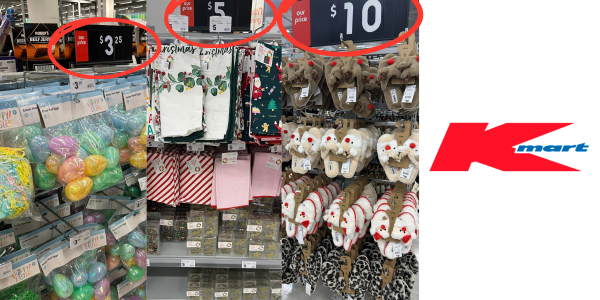Is Kmart tricking YOU into spending more with misleading tags?
A new type of tag has appeared in the aisles of Kmart stores nationwide, potentially enticing shoppers to spend more amid rising financial pressures in Australia.
The eye-catching red tags in Kmart are labelled as ‘our price’ and may seem to indicate a sale price within the store.
However, they are actually displaying the regular asking price of the product.
Interestingly, Kmart does not run sales at any point during the year.
While they do offer clearance items and reduced prices on over 100 products, you won't find traditional sales events like BIG W's toy sale.
This is because the retail giant actively promotes ‘everyday low prices all year round’.
University of New South Wales (UNSW) Business School Professor Nitika Garg told Yahoo Finance that additional tags all came down to consumer psychology.
Businesses like Kmart capitalised on the years shoppers had spent being conditioned to believe that certain colours or tags indicated a discount or promotion.
‘They are misusing that a little bit now,’ the professor said.
‘Targeting consumers to say, “Our price is $10’, but your price was always $10 is misleading because it’s not a promotion.”’
‘Coles has done the same with the locked-in prices. It makes people think it’s a deal, but it’s really saying, “We are holding the price as a constant”, and that is not a deal,’ the professor added.
‘I think they are doing it on purpose, so people misinterpret them as deals and subconsciously go for it.’
Garg, a specialist in emotions' effects on consumer decisions, found that people tend to remember products they want when on sale.
However, tags that ‘signal savings with colours’ can prompt them to buy, even when there are no actual savings at the cash register.
These advertising tactics are especially effective on shoppers experiencing financial stress during the current cost-of-living crisis.
‘A lot of consumers are stretched on money and stretched on time. Imagine you have young kids at home or a child with you in your shop, it makes it hard to do the due diligence required, and that’s when you fall for these tactics,’ Garg explained.
She pointed out that the responsibility now falls more on consumers to be watchful about such tactics, especially since regulations that could provide protection have been slow to catch up.
‘We don’t have regulations around this because they are not saying it is a deal. They are just signalling that with the colour, and regulations have yet to catch up with these tactics.’

She urged shoppers to remain vigilant amid rising living costs and the pursuit of better deals.
Kmart's overarching strategy aimed to position itself as the more affordable choice, and the ‘our price’ tags were in line with this brand promise, Garg clarified.
‘Coles did it in the same way when they decided they didn’t want to go head to head with Woolworths on quality, so they made price their promise as well,’ she added.
‘Now, you see all these yellow tickets and think they are deals, but they are being assigned to products that are not on any further promotion, which is confusing to the consumer.’
Smart shoppers might be annoyed, but it probably won't damage the profits of big companies like Coles and Kmart.
‘Who is the realistic competition for Kmart? We just don’t have someone in the market who could compete,’ Garg said.
‘But it’s not a good idea long term, as consumers do feel disappointed when they do it.’

Members, what do you think of Kmart's tactic to entice us to buy regular-priced items? Have you ever fallen for this before? Share your experiences in the comments below!
The eye-catching red tags in Kmart are labelled as ‘our price’ and may seem to indicate a sale price within the store.
However, they are actually displaying the regular asking price of the product.
Interestingly, Kmart does not run sales at any point during the year.
While they do offer clearance items and reduced prices on over 100 products, you won't find traditional sales events like BIG W's toy sale.
This is because the retail giant actively promotes ‘everyday low prices all year round’.
University of New South Wales (UNSW) Business School Professor Nitika Garg told Yahoo Finance that additional tags all came down to consumer psychology.
Businesses like Kmart capitalised on the years shoppers had spent being conditioned to believe that certain colours or tags indicated a discount or promotion.
‘They are misusing that a little bit now,’ the professor said.
‘Targeting consumers to say, “Our price is $10’, but your price was always $10 is misleading because it’s not a promotion.”’
‘Coles has done the same with the locked-in prices. It makes people think it’s a deal, but it’s really saying, “We are holding the price as a constant”, and that is not a deal,’ the professor added.
‘I think they are doing it on purpose, so people misinterpret them as deals and subconsciously go for it.’
Garg, a specialist in emotions' effects on consumer decisions, found that people tend to remember products they want when on sale.
However, tags that ‘signal savings with colours’ can prompt them to buy, even when there are no actual savings at the cash register.
These advertising tactics are especially effective on shoppers experiencing financial stress during the current cost-of-living crisis.
‘A lot of consumers are stretched on money and stretched on time. Imagine you have young kids at home or a child with you in your shop, it makes it hard to do the due diligence required, and that’s when you fall for these tactics,’ Garg explained.
She pointed out that the responsibility now falls more on consumers to be watchful about such tactics, especially since regulations that could provide protection have been slow to catch up.
‘We don’t have regulations around this because they are not saying it is a deal. They are just signalling that with the colour, and regulations have yet to catch up with these tactics.’

The study suggests that a brand's identity and colour choices can influence consumer preferences, allowing skilled marketers to shape buying habits and brand loyalty. Image source: Pixabay
She urged shoppers to remain vigilant amid rising living costs and the pursuit of better deals.
Kmart's overarching strategy aimed to position itself as the more affordable choice, and the ‘our price’ tags were in line with this brand promise, Garg clarified.
‘Coles did it in the same way when they decided they didn’t want to go head to head with Woolworths on quality, so they made price their promise as well,’ she added.
‘Now, you see all these yellow tickets and think they are deals, but they are being assigned to products that are not on any further promotion, which is confusing to the consumer.’
Smart shoppers might be annoyed, but it probably won't damage the profits of big companies like Coles and Kmart.
‘Who is the realistic competition for Kmart? We just don’t have someone in the market who could compete,’ Garg said.
‘But it’s not a good idea long term, as consumers do feel disappointed when they do it.’
Key Takeaways
- Kmart is accused of using misleading red tags labelled ‘our price’, which may appear as discounts but actually show the regular price.
- According to UNSW Business School Professor Nitika Garg, this is consumer psychology where certain colours or tags immediately signal a discount or promotion, but in this case, are misleading.
- Garg explains that consumers, particularly those already under financial strain, are vulnerable to such advertising tactics and urges shoppers to be vigilant.
- The professor points out that regulations protecting consumers against such tactics have yet to catch up, putting the onus increasingly on the individual consumer.









